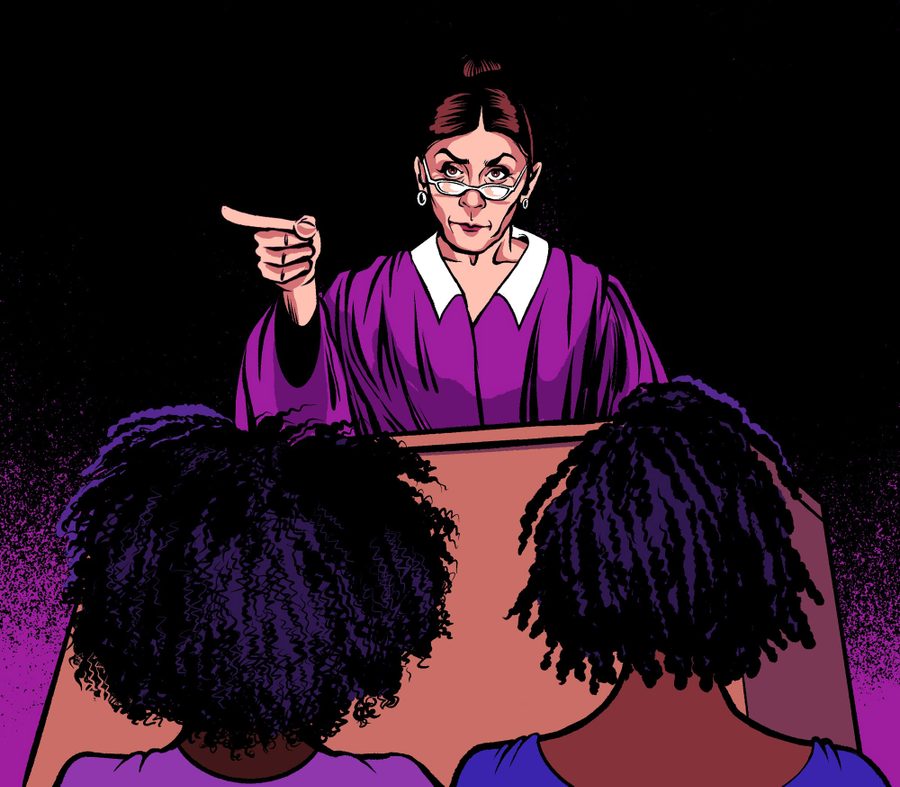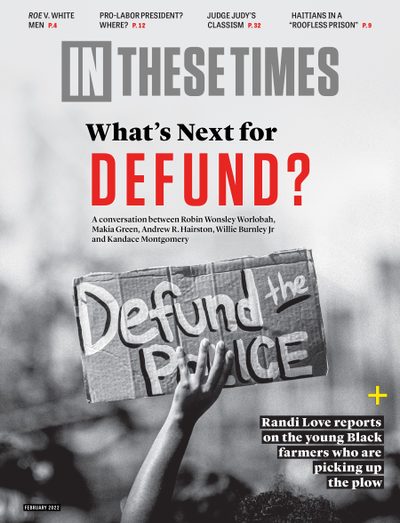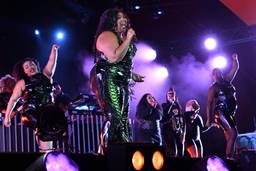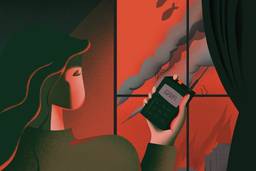The New Judge Judy Is As Classist As Ever
How a TV justice extends contempt for the poor.
Yasmin Nair

Judy Sheindlin, of the eponymous show Judge Judy, is so famous that, at a Shoah Foundation ceremony honoring former President Barack Obama, he was asked if he had ever watched her. Obama’s response was a classic example of Obamian diplomacy (Sheindlin was nearby, making things particularly awkward): “Who doesn’t love Judge Judy?”
It was a clever dodge, even if a little obvious. As it happens, millions watch Sheindlin even if they don’t love her—Judge Judy, which ran on CBS from 1996 to July 2021, occasionally outranked even Oprah in its ratings. It made Sheindlin a multimillionaire and the highest-paid daytime host. CBS was paying her $47 million a year by the time she parted ways with the network to start a new show, titled Judy Justice, on the Amazon-owned IMDb streaming service. Reports indicate she has so far received $25 million for the first season of 120 episodes, which debuted on Nov. 1, 2021.
Judy Justice is a reality show that features disputes over such matters as child custody, pet ownership and employment contracts. Sheindlin is a retired judge and serves only as an arbitrator, even though the set is made to look like small claims court. Participants sign contracts agreeing not to contest the results of the arbitration, and viewers are made to believe that the cases appear on Sheindlin’s docket as if she were an actual judge — though the cases are, of course, vetted. Like all reality shows, Judy Justice carefully chooses its participants. In fact, Sheindlin’s scouts scour legal cases across the country to find suitable candidates. One of the defining questions that determine inclusion appears to be: How much of a mess can you be on television?
The train wreck scenarios enable Sheindlin to pretend to be simply a benign and impartial judge trying to restore order among unruly people. This attitude allows her to show contempt for people of color and poor people (groups that often intersect on the show) and to be shockingly rude to them in ways she’d never dare with, say, wealthy or middle-class white people — all the while acting like someone who is forced to be overly stern with random people who just happen to behave badly, as she would have it, in front of her.
Nearly all of the people who end up on the show are poor or close to indigency, collapsing under mountains of debt as they struggle to keep up with demands of landlords, children and former spouses. Blouses have stains; some teeth are crooked or missing; pressed suits fall uncomfortably off the shoulders of those who have clearly been advised to “clean themselves up” for court. Judge Judy awarded a maximum payout of $5,000, an amount that has been doubled on Judy Justice; it’s likely the higher sum is designed to attract more participants. The show also flies people to California, all expenses paid.
In exchange for their appearance, participants agree to be humiliated and berated for the supposed choices that landed them there. They are screamed at by a woman who only works five days a month and who, after the shooting is done, hops on her private plane to jet back to one of her two homes in Naples, Fla. and Greenwich, Conn.
Episodes 25 and 26, for instance, linger over a dispute between two Black women whose families had taken a shared vacation in Florida. The plaintiff appears to claim the defendant still owes her money, though it’s hard to tell what the real issue is even after multiple viewings — because matters escalate quickly, with everyone screaming. Sheindlin asks probing questions that are unrelated to whatever the case might be but allow her to moralize. At one point, she wants to know whether the plaintiff drank while at dinner at an Applebee’s. When the woman says she had a glass of wine, Sheindlin prods her into confessing she may have had two. Sheindlin, in the manner of a nun, points out that wine lowers inhibitions. None of this information is related to the case, but Sheindlin is a white boomer multimillionaire who appears to sincerely believe her success is owed to her and that anyone who suffers deserves it. She has the air of the elder white Karen stereotype, the one who wears expensive athleisure on morning walks and picks up errant tin cans and places them in the trash while looking around to see which person (preferably someone of color) can be glared at accusingly.
These episodes have Sheindlin facing down a group of Black single women for whom it can be presumed a dinner at Applebee’s is a treat and for whom the money they were scraping together for a big vacation was a chunk of their bank balances. At one point, Sheindlin tells the plaintiff’s sister, also a grown woman, to uncross her arms and tells the defendant’s adult daughter to stand up straight without resting her chin on her arms, which are propped up on the bench. Finally, after Sheindlin has spent time asking for needless details and watching videos of shouting matches between undifferentiated people (she takes their phones to watch) that don’t seem relevant to the case, she decides they’re all being much too unruly and loudly screams SIT! four times to three of the women. It’s a shocking sight, to see a white woman so brazenly treat a group of Black women as if they’re dogs in need of training. Sheindlin then turns and says smugly to the audience and to her staff, “You see? I tried to play nice. If I can’t play nice, I play it any way you want to play it.”
The message is clear: These people won’t listen to reason unless you shout it at them.
Sheindlin, claiming she tried to “play nice,” offers her cover. It’s a way of saying, “I can’t control who comes into my courtroom — but I can control their behavior when they get out of line.” This self-presentation — of a no-nonsense judge who has the same set of rules for everyone — obfuscates the fact that cases seem like they are chosen specifically for their incoherence, and for plaintiffs who (hoping to make some amount of cash from their experience) may not have the cultural savvy to push back against the demeaning manner of a woman who appears in a position of authority. It also helps cover the fact that Sheindlin is an instigator, letting tempers boil over.
At the end of this two-episode “case,” Sheindlin simply tells both families to take out restraining orders against each other — something that could have been decided very early on with minimal fuss. An actual judge in an actual court, untroubled by the need to playact for the camera, would have made the decision in 15 minutes. But by the end of the second episode, Sheindlin has made it seem as if she had to suffer people so incapable of behaving that they need to be yelled at. There is, of course, a long and racist narrative of unruly Black people needing to be disciplined by stern white figures who are just there to show the right way to be. It’s a form of social and political control, legitimized by the charade of righteous justice being handed down through some kind of judicial process.
Sheindlin’s role as moral superior and social arbiter extends to white people as well, especially those who stray from normative standards of life and presentation. In one case, for instance, a gloriously punk woman wants to sue her ex-boyfriend on clearly specious charges of property damage. It emerges that she in fact stole his car and peed on the seats. The case is cut-and-dried even to a layperson, but Sheindlin extends the questioning needlessly while the camera lingers on the woman’s tattooed, buzz-cut, leather-jacketed person, admonishing her that she needs to move on from her ex — even though Sheindlin has no business or authority to say so. The message is simple: Look at this useless, actual punk.
Sheindlin’s vicious barking has become part of her lore, collected in various places on the internet for people to revisit and laugh over. It’s all part of her persona as everyone’s favorite stern Jewish mother, a low-rent Ruth Bader Ginsberg. This new, retooled version of Judge Judy knows better than to mess with the formula. The differences are superficial: Sheindlin’s robe is now burgundy instead of black, she has dispensed with her white lace collar and the set is nominally more modern looking (but still overwhelming in its wood-ness). The effect is of everyone operating inside a box. Despite the new influx of cash, Judy Justice looks as homey as its predecessor and as if it hires the cheapest camera operators and set designers. In early episodes, Sheindlin’s robe almost merges into the wooden panels of her chamber, lending her the look of a snarling Cheshire cat.

The most significant change is personnel. In a move that appears to have shocked even her longtime fans, Sheindlin chose a new bailiff, Kevin Rasco, without telling Petri Hawkins-Byrd — who had worked on Judge Judy for 25 years. According to Hawkins-Byrd, he only found out through the media and had to call Sheindlin to confirm. She apparently told him that paying him a salary that matched his experience was untenable (clearly, her own salary must have bankrupted Amazon), but did not acknowledge she could have talked to him first and at least tried to negotiate. Both Rasco and Hawkins-Byrd are Black, and Sheindlin has not publicly addressed the matter of what is, at the very least, an egregious personal insult to someone with whom she had a decades-long professional relationship.
The new show also features more on-screen staff. A law clerk, Sarah Rose Levy, sits to Sheindlin’s right, and a court stenographer, Whitney Kumar, sits to her left. They’re all extremely attractive and Levy is the most conventionally so, her porcelain skin, wide eyes and untroubled brow lending her the look of an expensive, vintage Dresden doll. She also happens to be Sheindlin’s granddaughter. At the end of every case, Sheindlin retreats to her chambers with Levy who, sipping delicately on the nectar of nepotism, proceeds to ask her grandma some softball questions. This gives Sheindlin a chance to further criticize the participants while delivering homilies about the necessity of personal responsibility, independence and bootstraps. (All irony dies on this show).
Of all the episodes so far, it’s episode 17 that most illuminates the anti-poor sentiments of Judy Justice. All the elements that make for salacious viewing are present: The plaintiff and defendant are mother and daughter (inter-family squabbles that dredge years of simmering resentments are a favorite), the case is mostly about a tummy-tuck procedure (cosmetic surgery is always a draw for audiences) and the entire story involves a large, possibly interracial family whose members mostly live (or have lived) under the same roof, including children with different fathers and the same mother (happily combining a “the poor breed too much” narrative with one about how “the poor just sleep around”). It gives Sheindlin the chance to do what she seems to love best: dispense her form of justice while demeaning and scolding people.
As the story unfolds, Annalise Araujo is being sued by her mother for charging $7,000 in tummy-tuck payments to her mother’s credit card. None of them appear to have much money beyond the basics, and yet Araujo claims the money was a gift — the sort one might expect from a wealthy socialite mother at Christmas — and that her mother was fulfilling a parental responsibility of sorts. There’s also the matter of car payments for a car that’s in both of their names, and it appears that Araujo has not been regular on that front either. Deciding the case is not a complicated affair, since the mother has a record of her daughter’s commitments to pay. But because this is Judy Justice, the money matters are beside the point. Sheindlin toys with Araujo, subjecting her to a barrage of questions designed not to elicit any useful facts but to reveal what she clearly thinks is a dumpster fire of a life.
It transpires that Araujo left her customer service job of seven years because of Covid-19 and to become a full-time homemaker, as she puts it to Sheindlin. Sheindlin grills Araujo with her characteristic cruelty and mocking contempt, demanding to know why she left her job and for whom she was a homemaker, the implication being that her new boyfriend could not possibly count. Sheindlin asks Araujo how much she made at her job — $600 a week. Then, how much does Araujo get from unemployment — $600 a week. At this point, Sheindlin lets out a “gotcha!” laugh and shares a smirk with her staff. Then she launches into a rant about what’s wrong with America: “The fact that you’re getting the same amount for not working as you did when you were working means that there’s something wrong with the government, which is why nobody can get anything done around this country now because everybody says, ‘We don’t have to work, now I can stay home, I can be a homemaker when I’m 26 years old.’ ”
Sheindlin’s contempt here is no surprise. She’s made similar comments before and once campaigned for Michael Bloomberg, who believed the poor needed to be taxed more so they would change their behavior and somehow, maybe, become less poor.
As she makes her judgment in favor of the mother, Sheindlin can’t resist getting in more digs at Araujo. “She needs a car because she’s a homemaker.” Then a stinging insult: “You’re 26 and you have four kids? Yeah, you have enough children for a while.”
This kind of eugenicist talk is directed at a young woman who doesn’t make for a particularly sympathetic figure as she rolls her eyes and insists her Social Security-dependent mother could easily pay for the procedure. The audience in the courtroom laps it all up, laughing every time the judge hurls another insult at Araujo, who stands seemingly unmoved by the vitriol. Afterward, Levy begins with what purports to be a sympathetic note, saying about Araujo, “The defendant and I are practically the same age and I couldn’t imagine trying to prioritize yourself that young with four children at such a young age, so that must be difficult. But priorities are always key. What do you think?” (Of course, this is like asking Rep. Lauren Boebert what she thinks of Muslims.) Sheindlin sighs, “You [should] think with your brain before you have a bunch of kids, with two fathers. The children who are the innocents always suffer — before you decide to have kids make sure you’re able to take care of them.”
Sheindlin’s dispensations of “justice” have little to do with resolving any legal issues. Instead, they’re about effectively imprisoning people inside societal expectations induced by their class positions. A suburban, upper-class housewife would not have been sneered at for calling herself a homemaker with her husband and for wanting a car to ferry her children to endless activities. But a working-class 26-year-old who wants to escape her life of childbearing and care and marriage, and who sees Covid-19 as a potential rescue plan, is rhetorically beaten back by a judge who has no problem hiring her own granddaughter as a doubtlessly high-paid “law clerk.”
Judy Justice is filled with contempt for anyone who isn’t, well, like Sheindlin herself. She’s enraged at people living off subsidies — after all, this means there might be fewer people to serve her breakfast at the Ritz or collect her trash for low wages. Even physical labor doesn’t impress Sheindlin. In episode 23, she looks at a photo of a wrought iron maker’s gate and sniffs that the object — simple but lovely — isn’t much by way of work (no doubt, her home’s own gates rival those at Versailles). As with the labor of childcare and homemaking in the case of Araujo, Sheindlin’s brand of justice, a highly popular one, involves erasing everything that people have to do and focusing only on who they are in her eyes: deadbeats who think they’re owed something.
Sheindlin has never been shy about her success or her wealth. Her biggest rival is the Judge Judy show, which now runs in syndication. As she put it nonchalantly when asked about the prospects for Judy Justice, “I did the math, and I’ve already got enough for 24/7 nursing care until I’m 150.” That all of her money has been made by working less each month than most Americans have sick leave has probably occurred to her; she just doesn’t care.
Sheindlin can’t send anyone to prison, but Judy Justice illustrates the carceral economy that undergirds American life, the one that dictates the poor and precarious need to always be terrified of the fear of harsh consequences for even the slightest infractions (lest they face an angry, white, berobed judge lady who berates and humiliates them). In the logic of this economy, the poor deserve whatever trials and tribulations they suffer; they will always need to have their lives, their money and even their bodies regulated by people with infinitely more resources.
Like its predecessor, Judy Justice is cruel and contemptuous toward the poor, but Sheindlin’s cruelty and contempt have earned her devoted fans among regular viewers and celebrities (including Amy Poehler, Nicki Minaj and Samuel L. Jackson). Judy Justice allows us to abdicate not just our responsibility for widespread inequality and dire poverty, but to turn all of that into a comforting spectacle. Sheindlin often notes that the people who show up in her court are also among her viewers (and many openly volunteer that information), a startling reminder that we’ve reached a stage in which shows like Judy Justice can numb us to the stark evidence of our own precarity.
Poverty, according to the show, is a result of individual choices; anyone who’s struggling deserves to spend the rest of their lives in misery. It’s not “justice” it peddles but the spectacle of people’s lives as they spin out of control.
Yasmin Nair is a writer, academic, and activist. She’s an editor at large at Current Affairs, on the editorial board of the Anarchist Review of Books, co-founder of the radical queer editorial collective Against Equality and the (Volunteer) Policy Director of Gender JUST. She’s currently working on her book Strange Love: A History of Social Justice And Why It Needs To Die. Her writing can be found at www.yasminnair.com.









